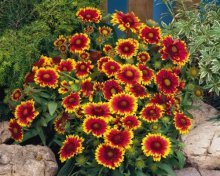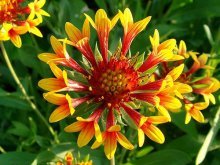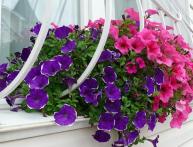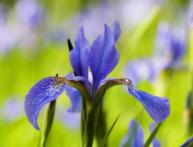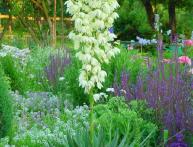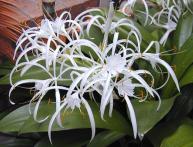Gaillardia - a colorful chamomile from North America
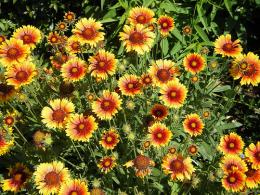
Gaillardia is a guest in many garden plots and flower beds. This popularity is due to the unpretentiousness and ease of propagation of the plant. Gaillardia can be annual, but the most in demand are perennial varieties that tolerate wintering quite well and do not require shelter.
Content:
What kind of plant is this?
In total, the genus Gaillardia has about 25 species. Depending on the variety, the plant has a height of 30 to 100 cm. As a rule, annual plants are short, perennials are massive and tall. Stems are erect and strong. The leaves are oblong, elongated, dark green in color.
At the end of the erect stems there is one flower, 5-12 cm in diameter. The petals are simple elongated or original tubular, collected in a crown. Some varieties have lush flowers and consist of several types of petals. The colors vary, but mostly yellow and orange. Sometimes there are varieties with pink and brick colors.
Flowers can be one-color or two-color. But the tips of the petals are almost always lighter than the central part, most often yellow. After the flowering period ends, a cone is formed at the end of the stem, which is actively used in compositions of dried flowers.
Flowering period gaillardia from the very beginning of summer until October. All this time she looks bright and elegant. It is only necessary to periodically remove faded stems.The flower fits perfectly in mixed flower beds. Low-growing varieties are used as borders, for planting in flowerpots and decorating alpine slides. Gaillardia lasts a long time when cut, so it is added to flower arrangements.
Planting and care
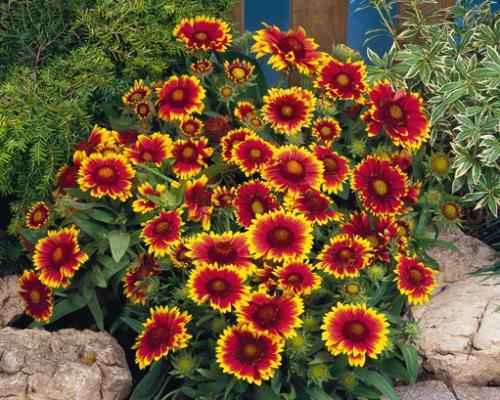
Although Gaillardia is unpretentious plant, but does not like acidic soils and shade. It also does not respond well to swampy soils and heavy watering. It tolerates moderate drought well and does not stop blooming even in dry summers. The only thing that a lack of moisture can result in is lower growth. Does not affect peduncles. For planting, it is better to choose sunny places with cultivated soils.
Gaillardia propagates by seeds or by dividing the bush:
- Planting of seeds is carried out at the end of April or at the beginning of May in open ground. It is possible to plant seedlings, but such labor costs are unjustified. The only thing that may be required when sowing is temporary covering of the soil on cold spring nights.
- By dividing the bush you can propagate the flower in autumn or spring. The dug out parts of the plants are placed in prepared holes and sprinkled with soil. Do not water abundantly. Plants are well received, but when propagated in rainy autumn they may get wet.
The plant doesn't like heavily fertilized soils and especially manure. When preparing for planting, a small addition of ash and mineral fertilizers to the soil is allowed, but without fanaticism. Also, do not water the soil abundantly when caring or planting. In the first year in the fall, the stems are cut off at the root and the top of the young plant can be covered with foliage or humus. In subsequent years, gaillardia requires shelter only in harsh northern regions.
Variety of varieties
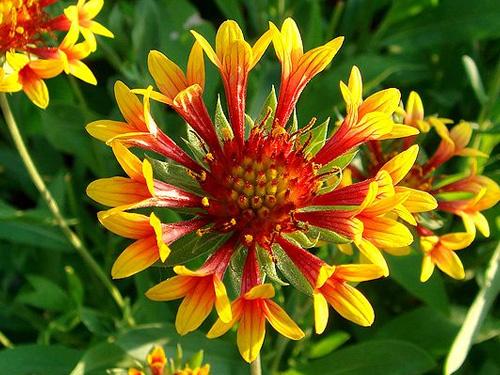
To date, breeders have bred a huge number of varieties, both perennial and annual. They differ in plant height, color and inflorescence shape.
Most Popular:
- Goblin. A perennial variety with large flowers (up to 8 cm in diameter), similar in appearance to a simple chamomile. Petals are burgundy, orange and brick with yellow tips. The variety is tall and requires staking if it blooms profusely.
- Laurentian (Laurenzian). Just a royal variety. An annual plant with magnificent lush inflorescences reaching a diameter of 10 cm. The height does not exceed 60. Most often a mixture of seeds of various shades is sold. The bushes are compact and small.
- Firebird. Most often it is a mixture of red and yellow lush flowers. A low-growing variety, plants rarely exceed 30 cm. They are actively used as borders and group plantings in flower beds.
- Arizona Sun. The shortest variety of bicolor daisies. The maximum height is 20 cm. It is distinguished by abundant and long flowering, which lasts until frost.
- Primavera. A compact perennial flower, up to 25 cm high. Up to 8 peduncles are formed from one rosette, at the ends of which there are flowers up to 12 cm in diameter. Suitable for growing in pots.
- Kobolt. Medium-growing variety with traditional yellow-purple flowers. The bushes are very branchy. About 40 cm high. Although it is considered frost-resistant, it requires shelter in severe winters.
- Fun. Tall (up to 80cm) perennial variety with large bright flowers. The bushes are massive, with branching shoots. Abundant flowering begins in the second year after planting. The flowering period is about 120 days. A very drought-resistant and unpretentious variety that grows even in poor sandy soils.
Variety of varieties gaillardias have made it a favorite among many gardeners.It is as popular as asters or gerberas, but has simpler agricultural technology. Which is what made her so popular.
Admire the beauty of gaillardia in the video:
Interesting information about the vegetable garden

